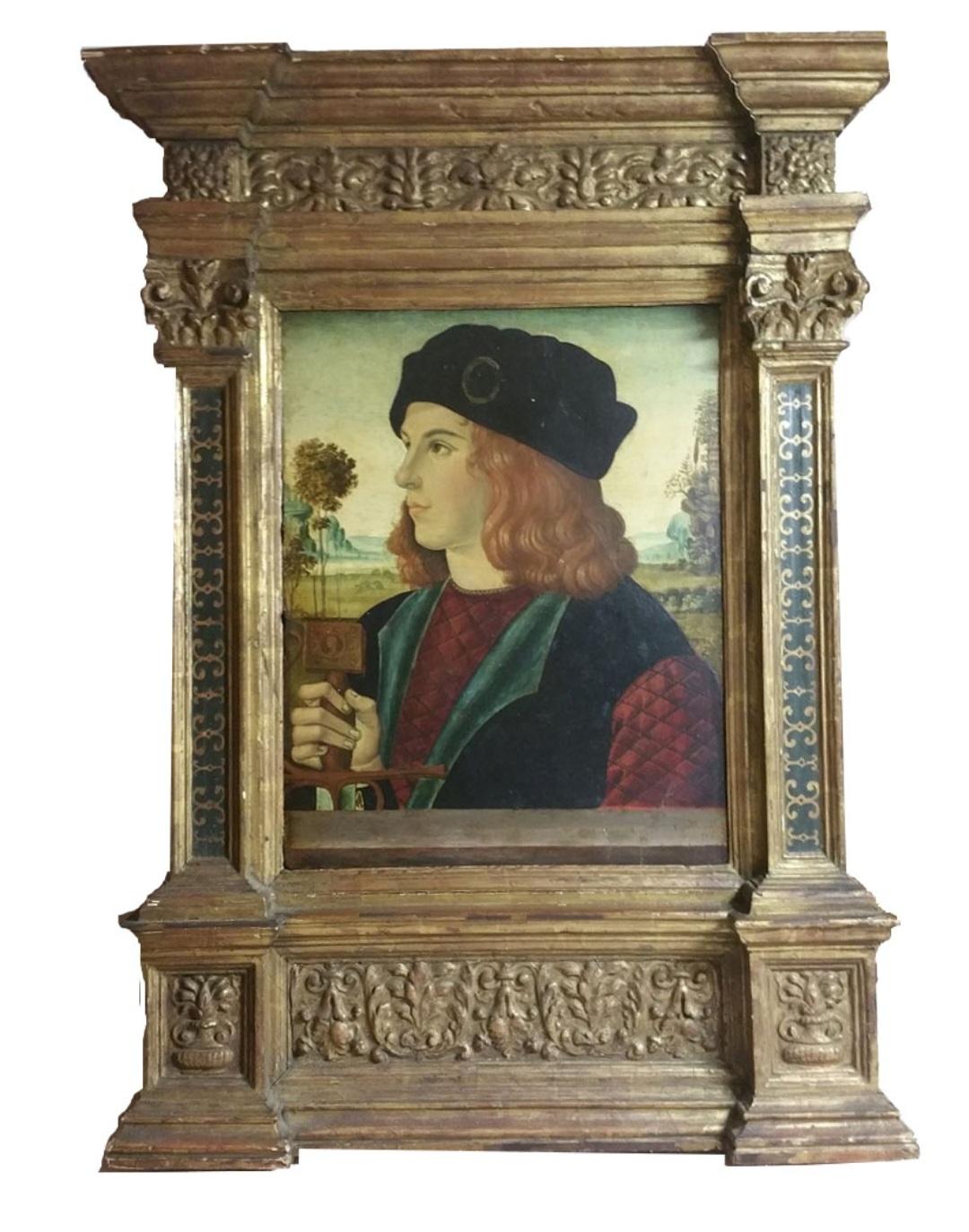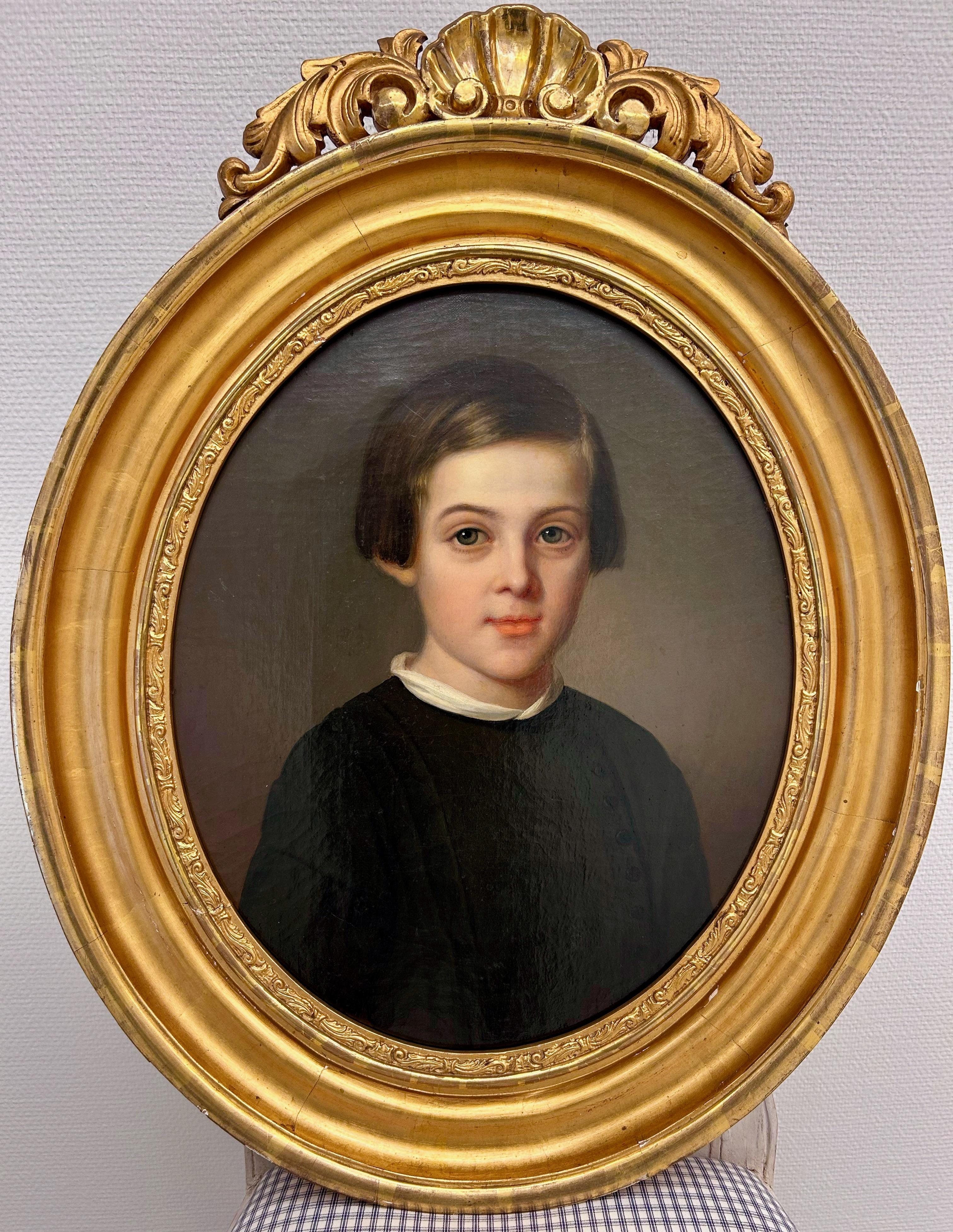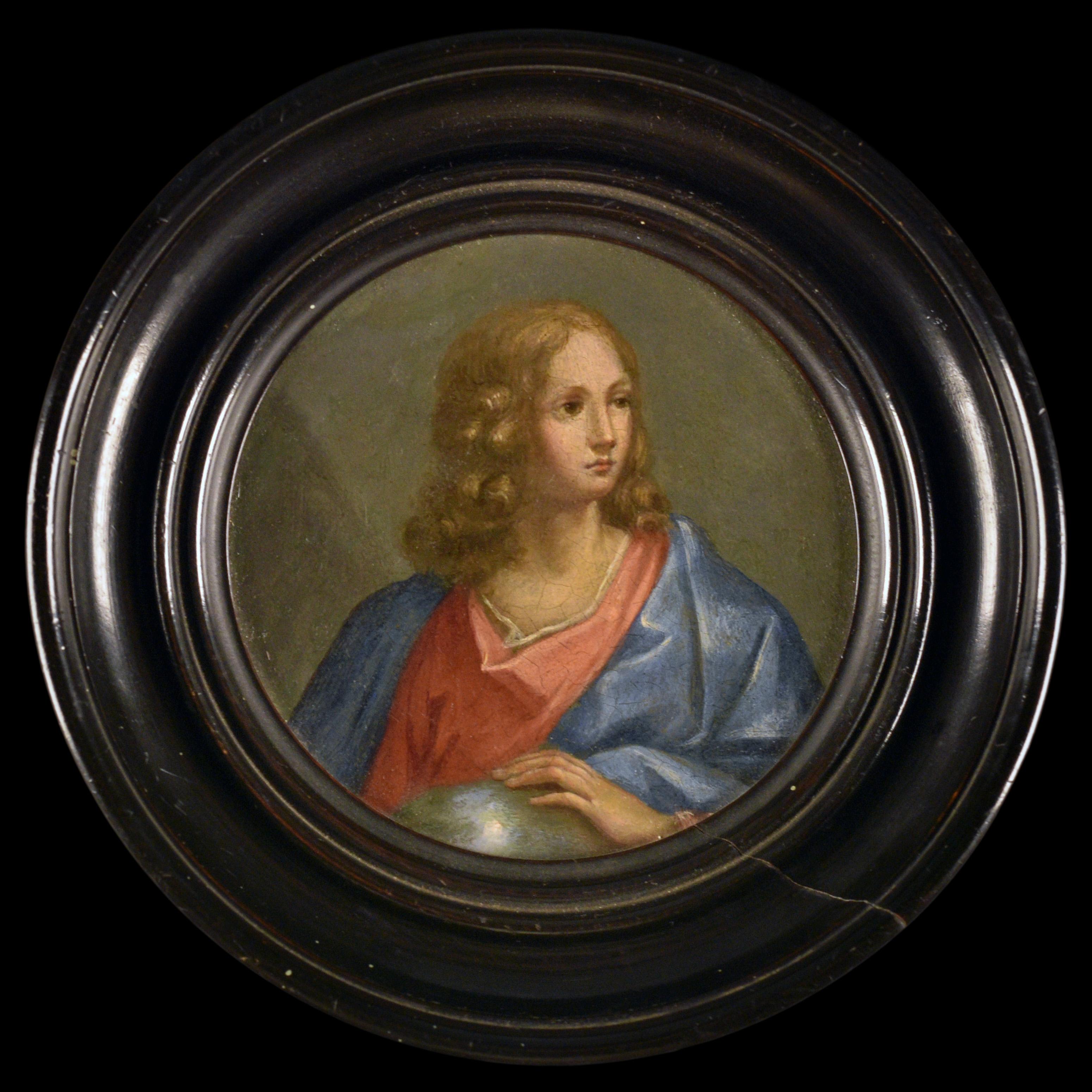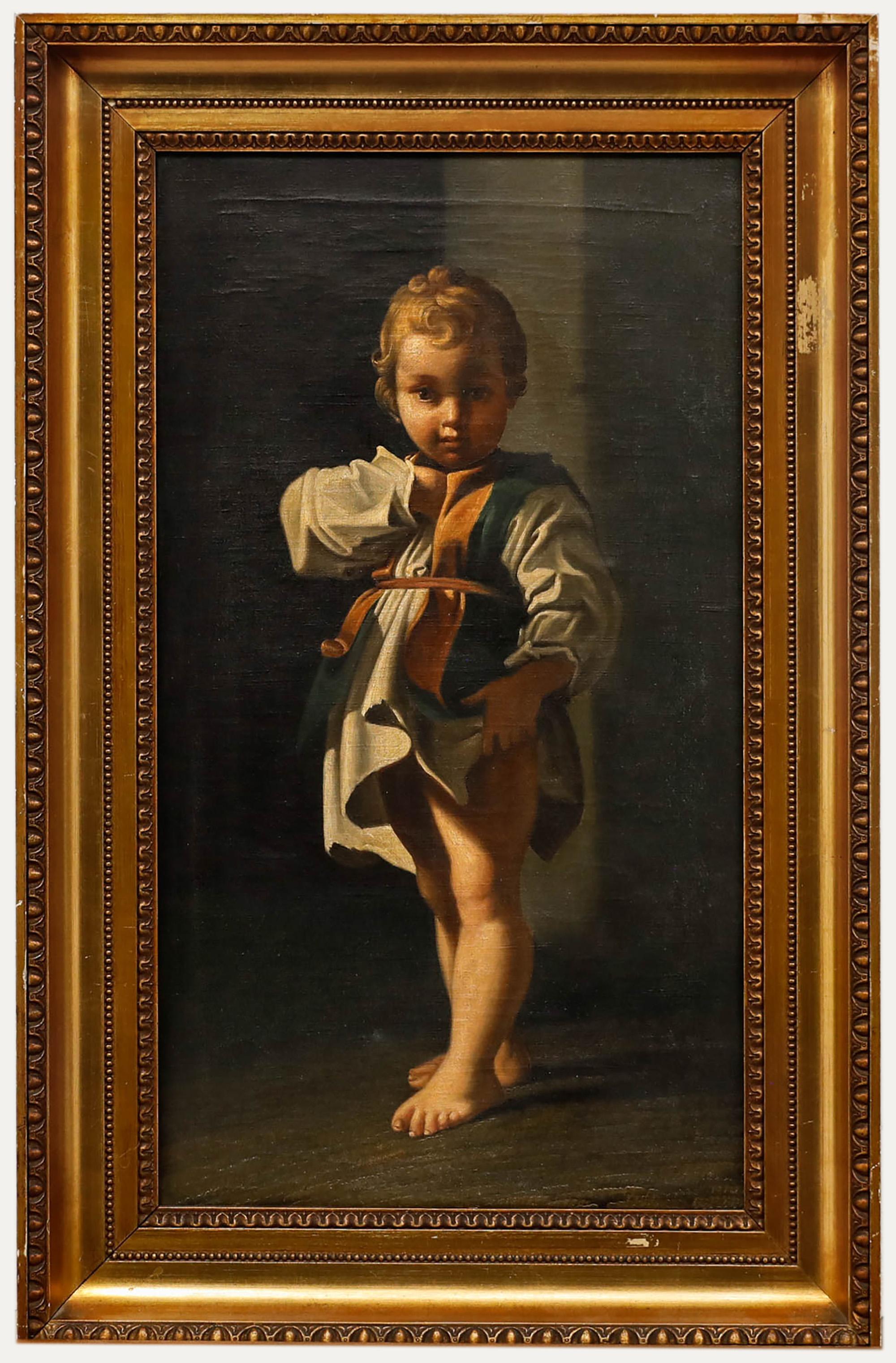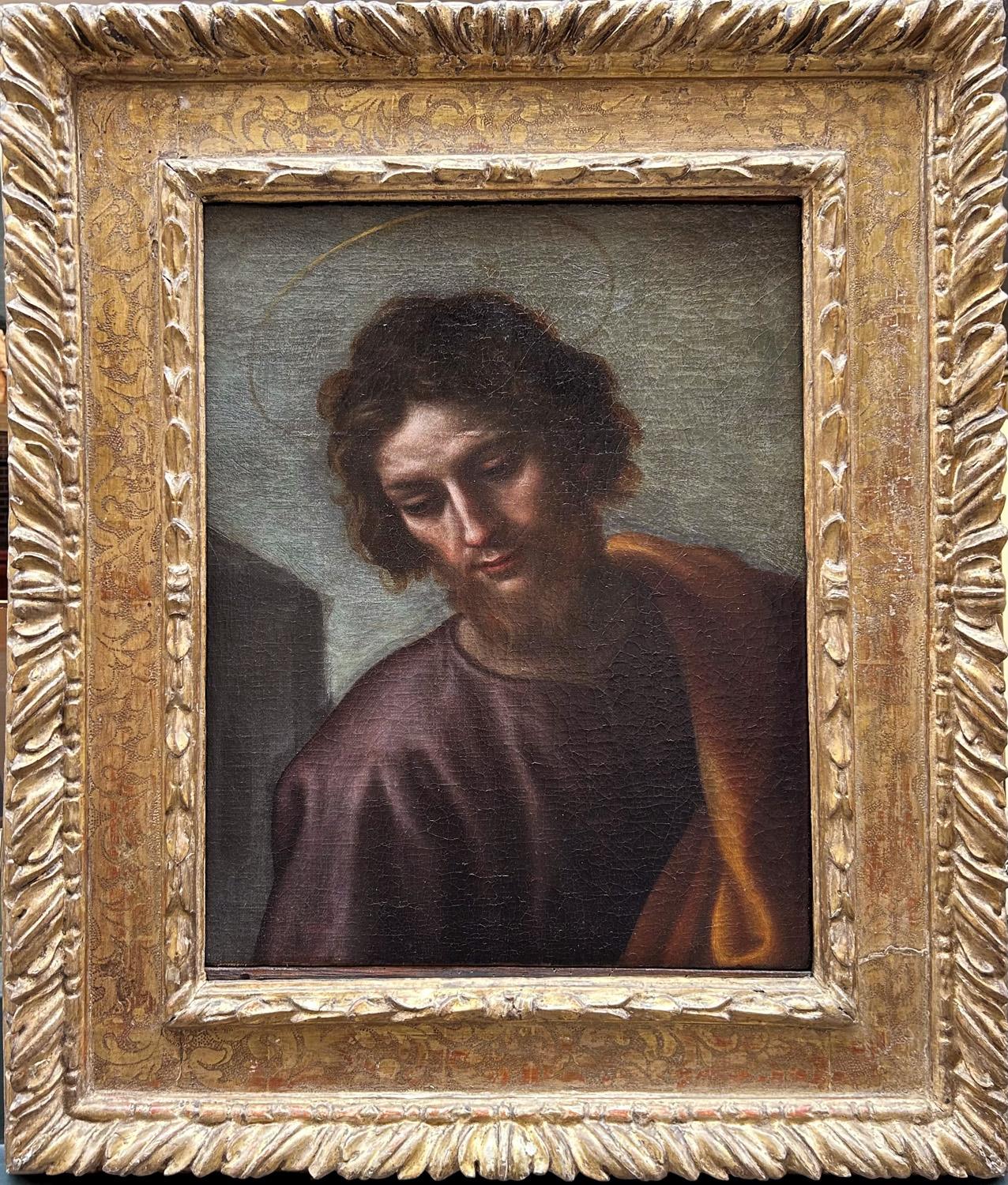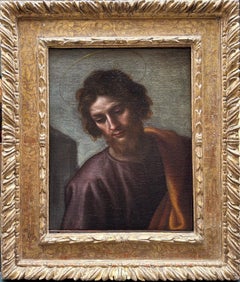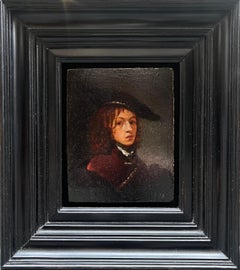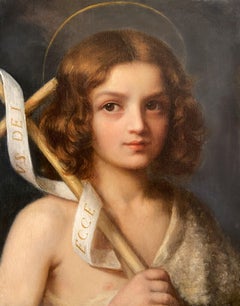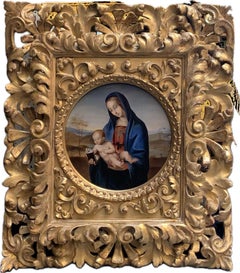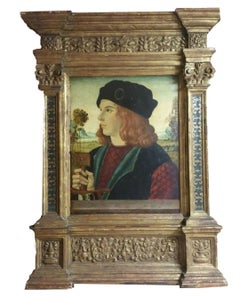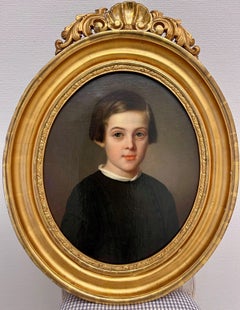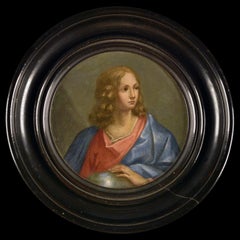Items Similar to Christ as a Boy
Want more images or videos?
Request additional images or videos from the seller
1 of 5
Christ as a Boy
$62,187.29
£45,500
€53,499.16
CA$86,825.77
A$94,698.55
CHF 49,788.64
MX$1,145,540.34
NOK 621,300.01
SEK 587,069.45
DKK 399,411.41
About the Item
Attributed to Francesco Bonsignori
Italian 1455-1519
Christ as a Boy
Oil on wood panel
Image size: 12 1/4 x 16 inches (31 x 40.5 cm)
Original gilt frame
In this painting on panel, Christ is depicted as a child, gazing innocently towards the audience. He is adorned in a red gown which contrasts the earthy deep green background. His long hair gently falls down to his shoulder, and he rests one hand on a wooden structure in the foreground. This portrayal captures a tentative and sensitive boy, embodying a sense of rosy innocence.
Francesco Bonsignori
Francesco Bonsignori, also known as Francesco Monsignori, was a distinguished Italian painter and draughtsman renowned for his mastery in depicting religious themes, portraits, architectural perspectives, and animals. He was born in Verona, where his father, Albertus Bonsignori, was an esteemed amateur painter.In the early stages of his career, Bonsignori’s artistic style was profoundly shaped by his teacher, Liberale de Verona. His career took a significant turn in 1487 when he became the portraitist and court artist for the esteemed Gonzaga family of Mantua. This period market a crucial phase in his artistic development, as he came under the influence of Andrea Mantegna, another prominent artist employed by Francesco Gonzaga since the 1480’s. Bonsignori and Mantegna Collaborated on several religious artworks, most notably those featuring the Madonna and Child.As Bonsignori’s career progressed, his artistic style underwent further changes, particularly in his use of form and colour. This development in his practice was decisively influenced by Lorenzo Costa, a contemporary artist whose techniques left a lasting impact on Bonsignori’s later pieces.
- Attributed to:Francesco Bonsignori (1455 - 1519, Italian)
- Dimensions:Height: 16 in (40.64 cm)Width: 12.25 in (31.12 cm)
- Medium:
- Movement & Style:
- Period:
- Condition:
- Gallery Location:London, GB
- Reference Number:1stDibs: LU52415850472
About the Seller
5.0
Vetted Professional Seller
Every seller passes strict standards for authenticity and reliability
Established in 2007
1stDibs seller since 2014
85 sales on 1stDibs
Typical response time: 2 hours
- ShippingRetrieving quote...Shipping from: London, United Kingdom
- Return Policy
Authenticity Guarantee
In the unlikely event there’s an issue with an item’s authenticity, contact us within 1 year for a full refund. DetailsMoney-Back Guarantee
If your item is not as described, is damaged in transit, or does not arrive, contact us within 7 days for a full refund. Details24-Hour Cancellation
You have a 24-hour grace period in which to reconsider your purchase, with no questions asked.Vetted Professional Sellers
Our world-class sellers must adhere to strict standards for service and quality, maintaining the integrity of our listings.Price-Match Guarantee
If you find that a seller listed the same item for a lower price elsewhere, we’ll match it.Trusted Global Delivery
Our best-in-class carrier network provides specialized shipping options worldwide, including custom delivery.More From This Seller
View AllJohn the Baptist
By Francesco Curradi
Located in London, GB
Oil on canvas
Image size: 17 x 21 inches (43 x 53 cm)
18th Century Carlotta frame
Provenance
Private Country Estate
When depicting John the Baptist artists often added an outer ga...
Category
17th Century Portrait Paintings
Materials
Canvas, Oil
Portrait of a Young Man
By (After) Rembrandt van Rijn
Located in London, GB
Pupil of Rembrandt
Portrait of a Young Man
17th Century
Oil on oak panel
Image size: 4 1/4 x 5 inches (11 x 13 cm)
Dutch ebonised frame
This small portrait is of a young man, staring inquisitively out towards the viewer. The realism of his appearance is striking, with great care taken in the depiction of the man’s features - for example, his full lips and the slight bump in the bridge of his nose. The man wears a rich burgundy doublet and a black cap and is adorned with gold accessories, indicating a degree of wealth - it is likely that this is a miniature portrait for a wealthy patron. The warm flesh tones of this painting and the intricate rendering of the man’s curly brown hair demonstrate the artistry of the painter, who has successfully captured the image of youth within his brushstrokes.
Rembrandt’s Pupils
Upon completing his artistic education, Rembrandt opened a studio and began to take students - the first of which were Gerrit Dou and Isaac Jouderville. The studio functioned as an art school, in which materials and guidance were provided - contrary to the studios of his peers, Rembrandt did not offer lodging to his pupils. The families of prospective pupils had to pay Rembrandt 100 guilders (enough for a house at the time) for this artistic education, and the profits from any works produced by pupils under Rembrandt would be paid to the master rather than kept by the student-artist - this contributed substantially to the master’s income.When taking on pupils, Rembrandt looked for those who could already paint, and guided their styles to reflect his. By choosing pupils who were somewhat experienced artists, Rembrandt had an array of painters that could be involved at any stage of assisting with the creation of his works - in this way, Rembrandt’s pupils often functioned as studio assistants as well. In order to perfect Rembrandt’s style, pupils would paint copies of their teacher’s works, sometimes adding their own distinct variations. They would use the same subjects and models as Rembrandt himself, and would accompany him on outdoor trips to paint nature and landscapes. The extensive copying and utilisation of same source materials has rendered Rembrandt’s work and the work of his pupils difficult to differentiate, even in the modern era.At least 50 pupils were taught by Rembrandt, with many continuing on to become his studio assistants. A few graduated into successful artists in their own right - for example, Govaert Flinck...
Category
17th Century Portrait Paintings
Materials
Oil, Oak, Panel
St John the Baptist as a Child, Early 19th Century Italian School, Oil Painting
Located in London, GB
Oil on canvas
Image size: 15 x 19 inches (38 x 48.25 cm)
Handmade gilt pierced frame
This is a beautiful early 19th Century Italian Old Master oil painting with the subject matter ...
Category
Early 19th Century Italian School Portrait Paintings
Materials
Canvas, Oil
Conestabile Madonna Old Master Renaissance
By (after) Raphael (Raffaello Sanzio da Urbino)
Located in London, GB
After Raphael
Conestabile Madonna
1483 - 1520
Oil on poplar panel
Image size: 8 x 8 inches (20.5 x 20.5 cm)
Original ornate hand carved gilt frame
Conestabile Madonna
Made in compos...
Category
16th Century Old Masters Portrait Paintings
Materials
Canvas, Oil
Portrait of a Young Girl Oil Painting 20th Century
Located in London, GB
Circle of Thomas Derrick
British 1885 - 1954
Oil on panel
Image size: 21 1/2 x 14 inches (55 x 36 cm)
Hand made frame
Category
1950s Portrait Paintings
Materials
Oil
Portrait of a Young Man
Located in London, GB
Oil on canvas
Image size: 13 x 16 1/2 inches (33 x 42 cm)
Contemporary style frame (Image below)
Provenance
Private European Collection
Darnley Fine Art offers this boldly brushed ...
Category
17th Century Portrait Paintings
Materials
Canvas, Oil
You May Also Like
Portrait of a Young Boy
Located in Saratoga Springs, NY
Attributed Federico Icilio Joni (1866-1946, North Italian Sienese)
“Portrait of a Young Boy”
17 ¾ x 14” (on poplar panel)
Icilio Federico J...
Category
19th Century Old Masters Figurative Paintings
Materials
Panel, Oil
$20,000
Italian Young Noble Prince Portrait
Located in Douglas Manor, NY
6054 Portrait of a young Noble Prince
Set in gilt frame
Image size 19.5x15.5"
Category
1980s Portrait Paintings
Materials
Oil
Portrait of a Young Boy - Oil on Canvas Circa 1850
Located in Stockholm, SE
Oval Portrait of a Young Boy (Johan Gustaf Moll, 1843–1912), attributed to Carl Ferdinand Sohn (1805–1867)
An intimate oval portrait of a young boy. Mounted in an oval gilt wood peri...
Category
1850s Other Art Style Portrait Paintings
Materials
Canvas, Oil
18th Century Italian oil on copper, Raphael School
By (after) Raphael (Raffaello Sanzio da Urbino)
Located in New York, NY
18th Century Italian oil on copper portrait in the style of Raphael. Excellent condition.
Category
18th Century Figurative Paintings
Materials
Copper
After Bartolomeo Schedoni - 19th Century Oil, Study of a Boy from 'The Charity'
Located in Corsham, GB
After Bartolomeo Schedoni (1578-1615). Italian School, Portrait study of a boy from the 1611 painting 'The Charity'. Oil on canvas. Well presented in a gilt effect frame with lambs t...
Category
19th Century Portrait Paintings
Materials
Oil
Sybil, 18th Century Italian School
By Guido Reni
Located in Blackwater, GB
Sybil, 18th Century
Italian School - After Guido Reni
Large 18th Century Italian Old Master depiction of a Sybil (Apollonian Oracle / Prophetess), oil on canvas. Beautiful quality ...
Category
17th Century Portrait Paintings
Materials
Canvas, Oil
$6,013 Sale Price
20% Off
More Ways To Browse
Antique Wood Christ
16th Century Italian Wood
Italian Paintings 16th Century
Coronation Robe
Enoch Seeman
Floyd Mayweather
Genoa Italy Painting
Gerard Ter Borch
Girl Portrait Painting 1960s
Late 19b Century American Nudes
Nun Portrait
Oil Portrait Spanish Woman
Oval Old Masters Paintings
Paintings Pre 1900
Portrait Of Sailor
Tim Fowler
Vittorio Corcos
Vittorio Matteo Corcos
